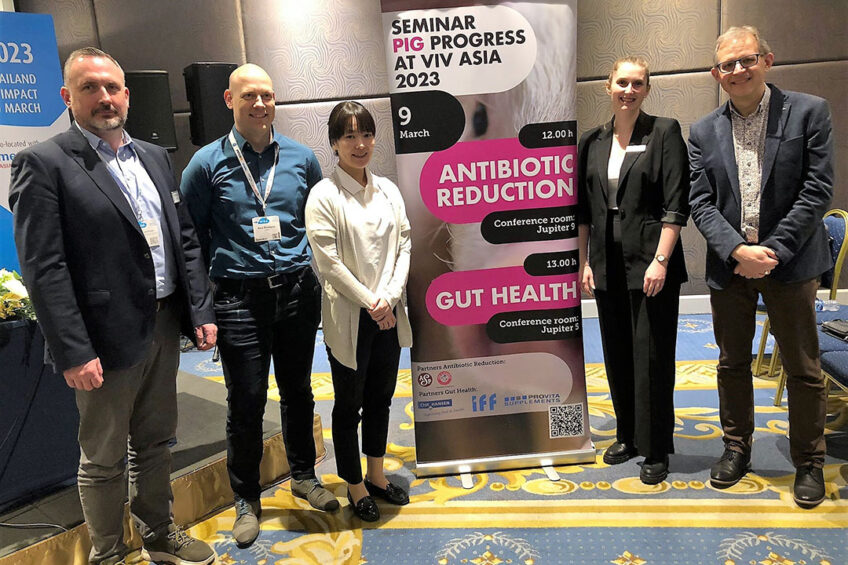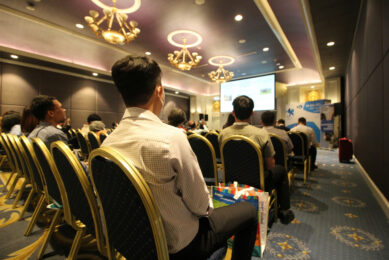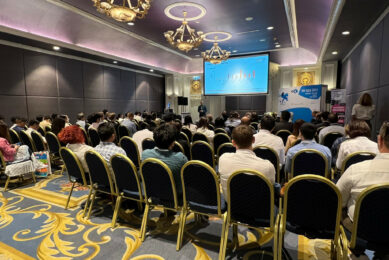On-demand: gut health seminar at VIV Asia

During VIV Asia 2023, in Bangkok, Thailand, Pig Progress hosted an in-person seminar about the topic of gut health. On March 9, 2023, 2 expert speakers discussed why gut health continues to be of the utmost importance in modern-day swine production, and how intestinal challenges can be tackled in sustainable ways. The seminar was recorded and is available for viewing on demand.
 Introduction to the theme of gut health
Introduction to the theme of gut health
The first speaker at the gut health seminar was René Bonekamp, at the time of VIV Asia senior researcher swine and product manager at Schothorst Feed Research (SFR). He presented “gut health” as a front-to-back journey, which starts when the animal is eating until the faeces is coming out.
In terms of feed intake and palatability, he pointed out that creep feed should be diverse to reach a greater feed intake. In addition, he said, piglets prefer soft pellets, and he addressed the question what raw materials are being used.
Stomach function
He then moved on to talk about the stomach function. Its essential function is to acidify the feed for pre-digestion purposes. Should the stomach not do its job optimally, nutrient digestion is sub-optimal. This leads to undigested nutrients in the hindgut. Add to that an impaired microbial barrier function, and the end result can be post-weaning diarrhoea. A focus on the acid-binding capacity can help, he said, taking into consideration the role played by crude protein sources, minerals or organic acids on acid binding capacity.
Role of the small and large intestine
With regard to intestinal development, he focused on the role of the small and large intestine. He said the small intestine is the place where starch is being digested and he emphasised that the right starch source matters. Wheat and corn both respond well to heat treatment. He also discussed protein digestion and fermentation, as well as fibre and fat.
 A functional intestinal barrier: The first line of defence
A functional intestinal barrier: The first line of defence
Next on stage was Dr Lea Hübertz Birch Hansen, product manager swine at Chr. Hansen. She began by addressing what a healthy gut looks like in pigs and also what the consequences are of a compromised intestinal barrier, having a “leaky gut,” allowing pathogens, but also undigested feed proteins or foreign antigens to enter the bloodstream.
Probiotics
She then turned to talk about probiotics. “Probiotics are live bacteria which, when administered in adequate amounts, provide a health benefit to the host.” She shared results of trials carried out with the product SolPreme, a dual-strain Bacillus-based probiotic which can be administered to sows and piglets.
Dr Hübertz Birch Hansen then summed up 3 modes of action, the first being adherence to an intestinal epithelium. She demonstrated that both strains used in this product competitively exclude adherence of enterotoxigenic Escherichia coli (ETEC) F4.
Increasing the mucus layer
The second mode of action is increasing the mucus layer. That was demonstrated in trials when mucosa thickness levels in pre-weaning piglets were shown to be significantly larger when provided with the probiotic.
Intestinal permeability
Thirdly she touched on preventing intestinal permeability as a mode of action, by discussing an E. coli challenge study carried out at the University of California, Davis. E. coli can lead to a state leaky gut she said, but when supplied with probiotics a situation of permeability can be prevented.
 Holistic approach towards gut integrity
Holistic approach towards gut integrity
Dr Torben Liermann spoke on behalf of the German animal nutrition company Provita Supplements. Emphasising that there is no “one solution” to replace antibiotics. His aim was to introduce a holistic approach towards gut health, using superior feeding concepts. Of course, he said, gut health is a combination of feeding, housing and management strategies. When building a weaning concept, he said, it’s vital to acknowledge that the majority of piglets will have an energy deficit at weaning.
Nutritional strategy with various components
The company offers a nutritional strategy with various components, one of which is based on “activated zinc oxide” (Maxactivat/Zn) as a novel trace mineral source, he explained. That higher available source of zinc oxide could supply an equivalent to therapeutical dosages, he said.
Use of probiotics
He also discussed the use of probiotics. He shared results from sow feeding in which the product MaxLac was fed to post-farrowing sows. That would stimulate the good bacteria, whilst suppressing the unwanted bacteria.
Solid State Fermentation
Thirdly, he touched on Solid State Fermentation (SSF) products, branded under the name MaxFerm Pro, based on Aspergillus strains and fermented on a wide range of substrates. “The goal we want to achieve is to make carbohydrases.” He pointed out 4 modes of action, all leading to protein release; he also mentioned so-called external effects related to gut integrity.
 Improving the nutribiotic state for optimised performance
Improving the nutribiotic state for optimised performance
The last speaker in this session was Yoko Noguchi, senior technical service representative for North Asia within Danisco Animal Nutrition & Health, part of IFF. She discussed energy consumption of pigs, and stated that 40% of the energy is used for lean and fat deposition (i.e. growth). In order to make that share grow, other components will have to come down. For that, she looked at “gut maintenance,” which makes up 16% of the total energy used. Gut maintenance means that the nutribiosis situation should be favourable – a word referring to the balance between nutrition absorption, the microbiome and the immune function.
Xylanase, beta-glucanase, amylase and protease
She introduced the product Porzyme TP100, consisting of xylanase, beta-glucanase, amylase and protease. At weaning, she said, pancreatic enzyme production in piglets drops, so exogenous enzyme supplementation would be helpful.
Essential oil with cinnamaldehyde and thymol
She also discussed the product Enviva EO, an essential oil containing cinnamaldehyde and thymol, which could balance the microbiota population, leading to an increased short chain fatty acid production, which leads to reduced tissue inflammation and is an additional energy source.
She closed off sharing the effects of supplying both products, done at trials in China. In groups of piglets (7-23 kg), ADG was 11.4% higher compared to a control group. Diarrhoea incidence was 63.3% lower than in the control group.











